Sleeve gastrectomy ameliorates endothelial function and prevents lung cancer by normalizing endothelin-1 axis in obese and diabetic rats
Rexiati Ruze, Ya-Cheng Xiong, Jian-Wen Li, Ming-Wei Zhong, Qian Xu, Zhi-Bo Yan, Jian-Kang Zhu,Yu-Gang Cheng, San-Yuan Hu, Guang-Yong Zhang
Abstract
Key words: Sleeve gastrectomy; Lung cancer; Endothelin-1 axis; Endothelial dysfunction;DNA damage; Obesity
INTRODUCTION
Emerging evidence implies that obesity is an independent risk factor for multiple types of cancer[1], and type 2 diabetes mellitus (T2DM), an obesity-related concomitant disease, can favor a suitable environment for tumor formation, progression, and metastasis by influencing several biochemical and physiological factors, such as adipokines, inflammatory mediators, and altered microbiome[2]. Endothelial dysfunction (ED) is a complication of both obesity[3]and T2DM[4], which refers to a proinflammatory and prothrombotic state[5], and is capable of impairing blood vessels,causing cardiovascular disease and end-organ damage. Fundamentally speaking, the anomaly of endothelins (ETs) is caused by the disrupted ET axis. ETs are a group of proteins comprising three 21-amino acid peptides (ET-1, ET-2, and ET-3), two distinct rhodopsin-like G protein-coupled receptor subtypes (ET-A and ET-B), and ETconverting enzymes (ECEs), which all jointly facilitate the generation of biologically active ETs[6]. Previous research has indicated that the ET axis effects numerous signaling pathways involved in the mediation of apoptosis and growth in different cells[7]. In cancer cells, the ET axis activates autocrine/paracrine feedback loops,promoting the development and progression of tumors[8], such as lung cancer[9],viaseveral different mechanisms[10].

Among the commonly known isoforms of ETs, ET-1 is the most clinically relevant which has the highest expression[11]and makes a significant contribution to ED in many ways[5]. ET-1 is originally secreted by endothelial cells through both constitutive and regulated (or rapid release) pathways[12], of which the downstream effects are regulated by ET-A and ET-B[6]. ET-A is mainly expressed in vascular smooth muscle cells, while ET-B is expressed in endothelial cells, vascular smooth muscle cells,macrophages, and platelets[13]. Several processes activated by the non-linear signaling network of extracellular binding of ET-1 to ET-A, for instance, cell proliferation,apoptosis, cell invasion and metastasis, angiogenesis, osteogenesis, and nociception[14-16], are involved in normal cell function as well as the development and progression of cancer. Hence, due to an organic abundance in both ET-A and ET-B,ET-1 plays various roles in mediating pulmonary carcinogenesis[17-19], and ED is a predictor of the diagnosis and prognosis of lung cancer[20]. Meanwhile, as a common but sometimes fatal lesion in normal cells, DNA damage can lead to canceration,where the double-strand break is deemed the most harmful type, resulting in the general and instant DNA damage response in cells and the phosphorylation of Ser-139 of the H2A histone family member X (H2AX) at the site of DNA damage (γ-H2AX foci)[21]. Hence, marking nuclear γ-H2AX in a certain cell population is considered a brilliant way of recognizing early DNA damage, which has been frequently applied in cancer studies[22-24].
Bariatric surgeries are universally performed as an effective treatment for severe obesity, T2DM, and other related comorbidities[25]. Besides, whether in clinical trials or animal studies, they have been shown to prevent or lower the risk of cancers[26-29],including lung cancer[30]. Unfortunately, compared to these apparent effects, little is known about the underlying mechanisms of lowered cancer risk after bariatric surgeries. Thus, based on the scarcity of relevant studies and the negative impacts of obesity and T2DM on endothelial function, tumor development, and the essential role of ET-1 axis in tumor pathogenesis of the lung, we speculated that there may be a correlation between the ET-1 axis with ameliorated endothelial function and lowered risk of cancer following bariatric surgeries. Herein, using an obese and diabetic rat model induced with a high-fat diet and streptozotocin, we investigated the potential effect of sleeve gastrectomy (SG) in improving endothelial function and lowering the risk of carcinogenesis by normalizing the ET-1 axis and ameliorating DNA damage.
MATERIALS AND METHODS
Animals and study design
The protocol of the current study is shown in Figure 1. Seventy male Wistar rats (200 g average body weight; SPF Biotechnology Co., Ltd., Beijing, China) were housed in independent ventilated cages under constant ambient temperature (24-26 °C) and humidity (50%-60%) in a 12-h light/dark cycle. The study protocol was approved by the Institutional Animal Care and Use Committee of The First Affiliated Hospital of Shandong First Medical University (China), and every effort was made to minimize the pain and discomfort of the study subjects. And in accordance with the 3R principle of humane experimental technique[31]to minimize the number of animals used, five animals were included in each sub-group that was divided by the postoperative time points (every 4 wk, see below), and to meet this sample size,animals were unequally and randomly divided into the following three groups based on their differences in postoperative mortality estimated during preliminary experiment (data not shown).
Group 1 representing control (C;n= 15): Animals were given a standard diet (15%of calories as fat; Laboratory Animal Center of Shandong University, Shandong,China) during the whole protocol, with no intervention made.
Group 2 representing sham-operated control (SH;n= 22): Animals were fed a highfat diet (40% fat, 42% carbohydrate, and 18% protein, as a total percentage of calories;Xietong Pharmaceutical Bio-engineering Co., Ltd., Jiangsu, China) for 8 wk and then received intraperitoneal injection of streptozotocin at a dose of 30 mg/kg body weight(0.01 mol/L citrate buffer, pH 4.5; Sigma-Aldrich, St. Louis, MO, United States) to induce hyperglycemia, followed by a sham surgery 1 wk later. In this group, two rats were excluded due to unaltered blood glucose after injection [fasting blood glucose(FBG) < 11.1 mmol/L for 3 d in a row]. Ultimately, 20 rats were qualified for further processing.
Group 3 representing SG-operated (n= 33): T2DM was induced exactly the same as the SH group, followed by SG at 1 wk after injection. For this group, three rats were excluded according to the same criteria as above.
Surgical procedures
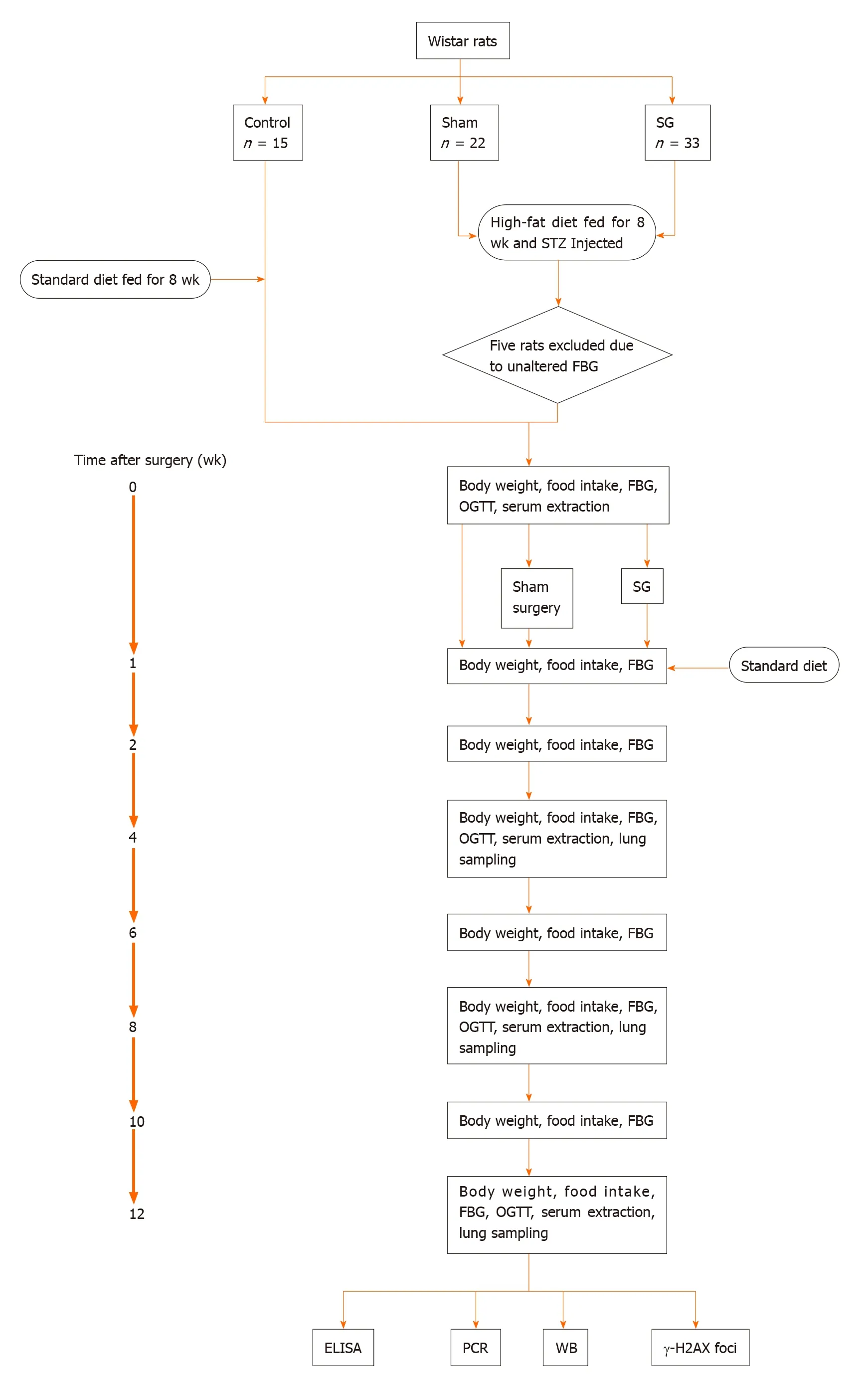
Figure 1 Flow chart of the study protocol. ELISA: Enzyme-linked immunosorbent assay; FBG: Fasting blood glucose; OGTT: Oral glucose tolerance test; PCR:Polymerase chain reaction; SG: Sleeve gastrectomy; STZ: Streptozotocin; WB: Western blot; γ-H2AX foci: H2A histone family member X focus assay.
Operations were performed following overnight fasting, with anesthesia being achieved by applying gaseous anesthesia (2% isoflurane). SG was performed as previously described[32]. Briefly, it involved the following steps: (1) A 4-cm midline epigastric incision was made to identify the structures; (2) The gastric omentum was dissected and the gastric cardium was disclosed; (3) The short gastric vessels, related gastroepiploic vessels, and branches of the left gastric vessels in the greater curvature were ligated and transected using 7-0 silk suture (Ningbo Cheng-He Microsurgical Instruments Factory, Zhejiang, China); (4) The gastric fundus and a large portion of the gastric body were removed; and (5) The residual stomach was closed using 5-0 silk suture (Ningbo Cheng-He Microsurgical Instruments Factory).
Laparotomy was performed on the SH rats to expose the stomach, esophagus, and small intestine. No other intervention was made. Furthermore, operative time was prolonged to induce a degree of comparable anesthetic stress that experienced by the SG rats.
For postoperative care, mixed tap water (4 g of white granulated sugar, 0.25 g of cefuroxime, and 0.4 g of ibuprofen dissolved in 500 mL of tap water) was given to rats in the SH and SG groups at 24 h after the operation for 3 d. Then, approximately 7 g of Total Nutrition Formula for Dietary Fiber (Nutren Fibre; Nestlé Health Science,Epalinges, Switzerland) was dissolved in 500 mL tap water and given for another 3 d.From postoperative day 7, all operated animals were given free access to a standard diet and tap water until the end of the protocol, same as the C group as abovementioned.
All C rats survived until the end of the protocol. Two rats in the SH group died of hyperglycemia during the postoperative period of 3 mo. Eighteen rats in the SG group survived, while the other 12 died of the following causes: Gastric leakage (n= 3),infection (n= 3), intestinal obstruction (n= 4), and unknown cause (n= 2; inconclusive on autopsy).
In all, 15, 18, and 18 rats survived in the C, SH, and SG groups, respectively, and to favor an equal sample size for each group, five rats in each group were randomly euthanatized by applying an overdose of 10% chloral hydrate (5 mL/kg) every 4 wk after operation. Hence, 15 rats of each group were included in this study. Body weight and food intake were monitored before the surgery and weekly in the first 2 wk after surgery, and then once in every 2 wk until the end of the protocol at the 12thweek after the operation. Blood samples were collected before the surgery and mensal euthanasia, followed by tissue sampling and preparation for further testing.
Blood chemistry
FBG level was measured with a glucometer (Roche OneTouch Ultra?; LifeScan,Johnson and Johnson, Milpitas, CA, United States) at the abovementioned time intervals, same as measurements of body weight and food intake. Blood was collected from the tail vein in unconscious rats and samples were centrifuged at 3000 rpm for 8 min; the serum was then extracted and stored at -80 °C. Serum insulin was measured with ELISA kits (CUSABIO, Hubei Province, China). Furthermore, the homeostasis model assessment of insulin resistance (Homa-IR) was used to estimate the degree of insulin resistance, which was calculated with the following formula: Homa-IR =fasting serum insulin (mIU/L) × FBG (mmol/L)/22.5[33].
Oral glucose tolerance test
Oral glucose tolerance test (OGTT) was performed before the operations and at 4, 8,and 12 wk after surgery. After an overnight fast, rats were administered with 1 g/kg glucose by oral gavage. Blood glucose was measured in conscious rats at 0, 10, 30, 60,and 120 min after the gavage. Area under the curve for OGTT was calculated by the trapezoidal method.
Quantitative real-time polymerase chain reaction
Total RNA was extracted using TRIzol reagent (Invitrogen, Carlsbad, CA, United States). The cDNA was synthesized using random primers (Servicebio, Hubei, China)and Revert Aid First Strand cDNA Synthesis Kit (#K1622; Thermo Fisher Scientific,Waltham, MA, United States). Quantitative real-time polymerase chain reaction (PCR)was performed on a Cycler System (StepOne Plus; Applied Biosystems Inc., Foster City, CA, United States), with the analyses being performed using the FastStart Universal SYBR Green Master (Servicebio) in a total PCR reaction containing 25 μL of quantitative PCR Mix, 2.0 μL of 7.5 μmol/L primers, 2.5 μL of reverse transcription product, and 8.0 μL of double-distilled H2O. The specific sequences of the primers for analyzed genes are shown in Table 1.
Western blot analysis
Lung tissues were homogenized and centrifuged at 12000 rpm for 10 min.Supernatants were extracted and the protein concentration was determined with a BCA kit (G2026; Servicebio). Protein solution was added into the loading buffer(G2013; Servicebio) in a ratio of 4:1 and denatured in boiling water for 15 min.Samples were loaded on 5% SDS-PAGE gels (Servicebio), then separated byelectrophoresis and transferred onto polyvinylidene fluoride membranes (Millipore,Burlington, MA, United States). After being blocked in 5% fat-free milk for 1 h,membranes were incubated overnight with the following primary antibodies: ET-1(ab117757; Abcam, Cambridge, United Kingdom), ET-A (ab85163; Abcam), ET-B(ab262694; Abcam), ECE-1 (sc-376017; Santa Cruz Biotechnology, Dallas, TX, United States), and GAPDH (ab9485; Abcam). The next day, the membranes were incubated in horseradish peroxidase-conjugated secondary antibodies, which were diluted 3000 times with Tris-buffered saline Tween-20. Bands were visualized with ECL solution(Servicebio) and the band intensity was quantified using ImageJ software (National Institutes of Health, Bethesda, MA, United States).

Table 1 Specific sequences of primers used in polymerase chain reaction analysis
Immunohistochemical analysis of γ-H2AX
Paraffin sections (5 μm) of the lungs were deparaffinized, rehydrated in a solution series (xylene 15 min thrice, absolute ethyl alcohol 5 min twice, 85% ethanol 5 min once, and 75% ethanol 5 min once), and washed with distilled water. Then, they were put into citrate antigen retrieval solution (pH 6.0), followed by a 3% hydrogen peroxide solution and incubation in darkness at room temperature for 25 min.Afterwards, the slides were placed in phosphate-buffered saline (pH 7.4) and washed thrice on the decolorization shaker (5 min each) to block the endogenous peroxidase activity after deparaffinization and antigen retrieval. Anti-histone γ-H2AX antibody(ChIP grade, 1:2000, ab20669; Abcam) was used and an appropriate elite horseradish peroxidase-diaminobenzidine system was applied to reveal antibody. The sections were counterstained with hematoxylin. Finally, the sections were dehydrated through an alcohol and xylene gradient and sealed with neutral gum.
When completed, the sections were made into electronic slides using the Pannoramic Digital Slide Scanners (Pannoramic DESK, P-MIDI, P250 and P1000;3DHISTECH Ltd., Budapest, Hungary). Then, a slide representing each animal was randomly selected and covered with FOV rectangles in CaseViewer v2.0(3DHISTECH Ltd.), and five fields at× 800 magnification from different rectangles were chosen for subsequent image analysis using the ImageJ software for semiquantitative analysis. A γ-H2AX-positive nucleus (i.e., a double-strand breakdamaged nucleus within a cell population counterstained by hematoxylin) was easily distinguishable when a homogeneous brown precipitate was observed covering partial or entire nucleus compared to the undamaged nucleus, which was colored blue. Levels of DNA damage in each group at different time points are expressed as the average percentage of γ-H2AX positive (brown-stained) to negative (blue-stained)nuclei of the sections.
Statistical analysis
Results were analyzed using two-way ANOVA with Tukey’s multiple comparison tests (GraphPad Prism 8.3; GraphPad, La Jolla, CA, United States).Pvalues < 0.05 were considered significant. Data are expressed as the mean ± SE of the mean.
RESULTS
Metabolic parameters
SG brought a significant improvement to the metabolic disorder (Figure 2). An increase in both body weight and food intake was noted in all the three groups, where C rats had a steady increase but the other two groups (SH and SG) showed a decline during the early postoperative stage (Figure 2A and B, Tables 2 and 3). In terms of the glycemic change (Figure 2C-F, Tables 4-7), the FBG of the C group stayed nearly unaltered, which was verified by OGTT, with a slight increase being noted. Similarly,despite the elevation in the fasting serum insulin level, the Homa-IR of the C animals did not change much, either. The SH group, in contrast, showed a continual FBG increase, which was further reflected by OGTT. Moreover, although the fasting insulin levels of the C group were not significantly different from those of the other two groups at most of the time points, the SH animals demonstrated an aggravated insulin resistance. On the other hand, the rapid reduction in body weight and in food intake was accompanied by the FBG returning to normal in the SG rats; the results of OGTT were nearly the same as in C rats. However, from the middle and late postoperative periods, the FBG of some SG rats began to rise. The fasting serum insulin levels of the SG animals increased after surgery but were not significantly different from those of the other groups. Nevertheless, similar to the results of FBG and OGTT, Homa-IR of the SG rats increased with age but was still much lower than that of the SH group. These results indicated that SG improved glycometabolism and insulin sensitivity in obese and diabetic rats with a rapid weight loss and reduction in food intake.
Gene expression of ET-1 axis
The mRNA expression of genes of the ET-1 axis are shown in Figure 3 and Tables 8-11. On the whole, C rats manifested steady expression in these genes, where an increase was notable in SH animals, even though the differences between the other two groups were not so conspicuous throughout the postoperative period. SG showed an effect of lowering, in other words, normalizing, the overexpressed genes. ForET-1,the SG group had lower expression than the C group at postoperative weeks 4 and 8,which was significantly lower than that in SH rats at the 8thand 12thwk after surgery.ForET-A, both SH and SG animals had an elevation at the last time point, yet a significant difference existed only between the C and SH animals. Similarly, with an obvious rise inET-Bexpression at postoperative week 12, the SH group had significantly higher expression than the other two. As forECE-1, an elevation was seen in both the SH and SG groups over time, with the former being significantly higher than the latter at the first time point. The C group was opposite, having much lower expression than the SH group at postoperative weeks 4 and 12. Although not entirely capable of offsetting the gap between C and SH animals at all time intervals,the SG group had normalized abnormalities in the ET-1 axis, indeed.
Protein expression of ET-1 axis
Results of protein expression of the ET-1 axis were not absolutely consistent with those from PCR tests (Figure 4 and Tables 12-15). In terms of the expression of both ET-1 and ET-A, a decrease was seen in the C group, which was opposite in the SG group. The SH group, however, was inconstant in the expression of ET-1 and the same as that in the SG group for ET-A. For both ET-1 and ET-A, the C group had lower expression, which was directionally opposite in the SG group; the SH group,however, was inconstant for the former but the same as in the SG group for the latter.The C group showed nearly steady or slightly increased expression in ET-B and ECE-1 as the animals aged, and the SG group showed gradually decreasing expression in these two proteins. The SH group showed continually increasing expression in ET-B and a maintained high level of ECE-1 expression.
DNA damage
The representative images of the γ-H2AX assay are shown in Figure 5. These images provide an intuitionistic comparison among groups, where it can be seen that there were more γ-H2AX-positive nuclei (red arrows) in the SH group than in the other two groups (Figure 5A). Furthermore, the semi-quantification analysis confirmed that the SH rats had more γ-H2AX-positive nuclei compared to the other two groups (Figure 5B and Table 16), indicating that cells in obese and diabetic rat lungs suffer from much more severe DNA damage than those in healthy and SG-operated rats.
DISCUSSION
Our rat model-based study demonstrated elevated expression of genes and proteins of the ET-1 axis and increased DNA damage in obese and diabetic lungs, indicating a deteriorated endothelial function and a greater risk of cancer development. However,all these alterations were able to be ameliorated by SG, a marvelous treatment for metabolic disorder that is competent in preventing or lowering the risk of various types of cancer as well.

Table 2 Comparisons of body weight (g) among groups
Being crucial for maintaining vascular homeostasis, the endothelium modulates blood flow, nutrient delivery, vascular smooth muscle cell proliferation and migration, fibrinolysis, coagulation, inflammation, and platelet and leukocyte adherence[34]. In contrast, ED, a common complication of both obesity and T2DM, is one of the concrete manifestations of this homeostasis being destroyed, which ultimately results in hypertension, thrombosis, and various cardiovascular diseases[35].So far, it has been known that adipose tissue inflammation, nitric oxide bioavailability, insulin resistance, and oxidized low-density lipoprotein are the main contributors to obesity-related ED[35]. Under the diabetic condition, ED is mainly caused by hyperglycemia, insulin resistance, abnormal cell growth factors, and vasoactive substances[36]. With its elevated release from adipose tissue, ET-1 exerts an anti-insulin effect by reducing the expression of insulin receptor, insulin receptor substrate-1, and phosphodiesterase-3B, while increasing the expression of ET-B[37]. As a result, more fat deposition is induced by fatty acids released from the visceral adipose tissue because of the insulin resistance[38]. Combined with the dramatically increased protein expression of ET-A, ET-1 leads to more lipolysisviathe activation of ET-A in adipose tissue[35]. On the other hand, the balance between endothelial-derived relaxation and contraction factors is disrupted in T2DM where the vasodilator factors(i.e., nitric oxide, prostacyclin, and endothelial-derived hyperpolarizing factor) and vasoconstricting factors (i.e., ET-1, angiotensin II, and prostaglandin) are inordinate[36].ET-1, as one of the serum markers of ED, can be transcriptionally increased by enhanced glycosylated end-products (known commonly as AGEs) in patients with poorly controlled blood glucose[39]. Therefore, ET-1 is considered a predictive factor for diabetic complications[40].
Regarding the close relation of the ET axis with cancer development, former studies have stated that cancers can be divided into three types based upon the expression level of endothelin receptors[41], and lung cancer belongs to the third type based upon its characteristic overexpression of ET-1, ET-A, and ET-B altogether[42], which is in line with our findings. The overexpression of ET-A in cancer has been shown to be associated with invasive biological behavior[43], while the expression of ET-B has been linked to lymphoid infiltration[44]. Considering the important role of the ET-1 axis in carcinogenesis, it has been targeted in pharmacotherapy for cancers, such as ECE inhibition and antagonism of ET-A and ET-B[45]. Although a noncancerous animal model was used, and the similar ET-1 alteration profile may not lead to cancer in these obese and diabetic animals, it is still a perfect example of obesity and T2DM providing a suitable environment for tumor formation. Further comparisons between the SH and SG groups of rats suggested that SG normalized the ET-1 activity profoundly, just as it did in reducing body weight and stabilizing glycometabolism.Consistent with this, it was reported in a clinical trial that SG can reduce plasma ET-1 levels[46]. Moreover, it was suggested by another study, which made a comparison to normalized blood glucose, that weight loss is much more important in the regulation of circulating levels of ET-1 in morbidly obese subjects[47], which also explains why the T2DM in some SG animals seemed to relapse in the middle and late periods after surgery while they still showed positive changes in the ET-1 axis.
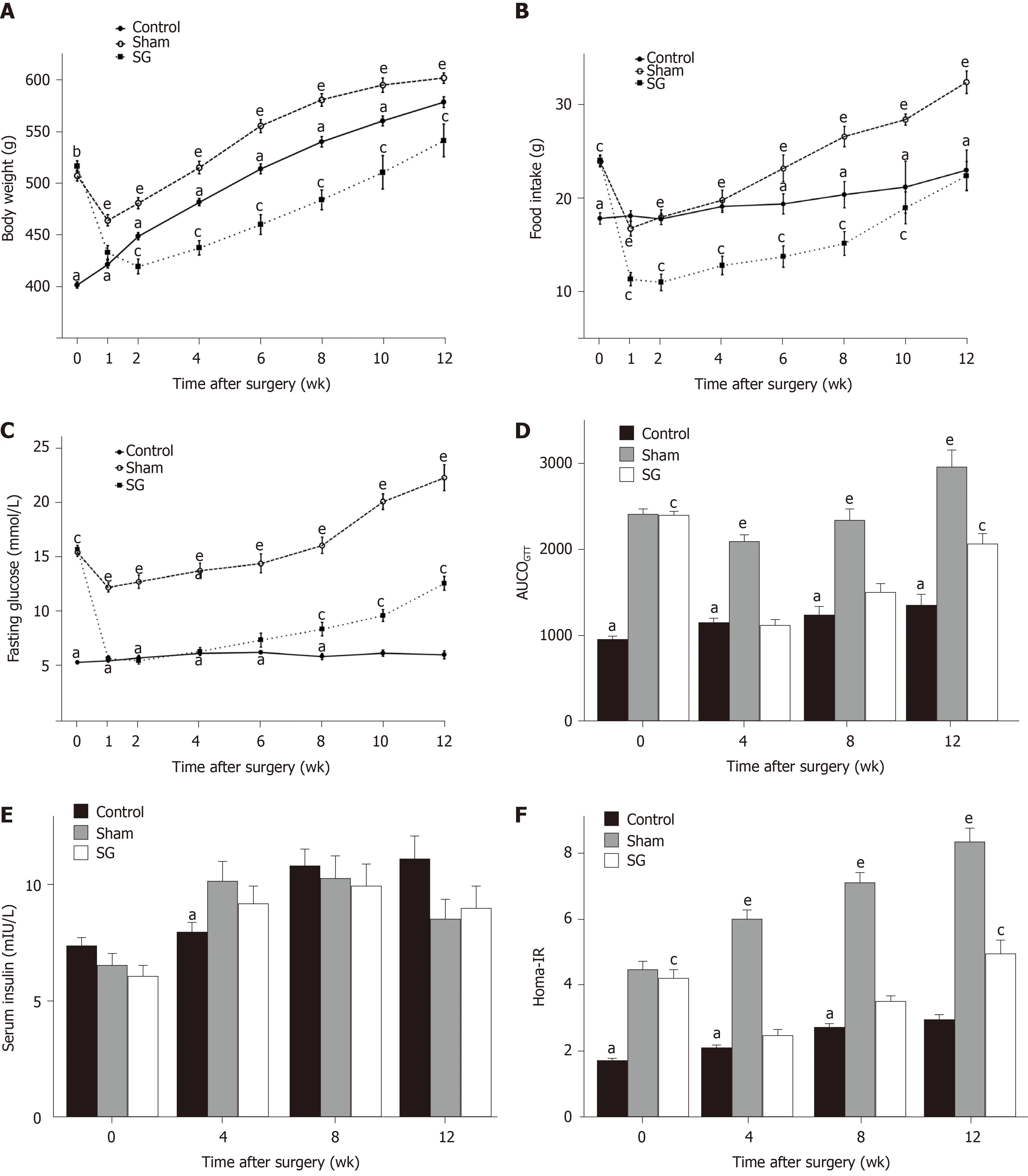
Figure 2 Comparisons of metabolic parameters among groups. A: Body weight; B: Food intake; C: Fasting glucose level; D: Area under the curve of oral glucose tolerance test; E: Fasting serum insulin level; F: Homeostasis model assessment of insulin resistance compared to sham-operated and control rats. aP < 0.05: Control vs sham; cP < 0.05: Control vs sleeve gastrectomy; eP < 0.05: Sham vs sleeve gastrectomy. AUCOGTT: Area under the curve of oral glucose tolerance test; Homa-IR:Homeostasis model assessment of insulin resistance; SG: Sleeve gastrectomy.
DNA damage is a parameter of evaluating the risk of developing cancer, and it affects DNA replication, leading to mutations, and lowers cell metabolism and survival[48]. In obesity, DNA damage is closely related to chronic inflammation,reactive oxygen species, oxidative stress, and cytokines[49]. Meanwhile, the activation of certain oncogenes induced by DNA damage can cause diabetes[50,51]. And as introduced, diabetes is correlated with DNA damage, mutation, and canceration[52].Since γ-H2AX is a regular marker of DNA damage response, its level can reflect the risk of canceration. A higher level of γ-H2AX was found in precancerous tissues,when compared to that in tumors in a lung cancer rat model induced by chronic inflammation[53]. Likewise, high level γ-H2AX is also related to oxidative stress and type 1 DM in adolescents[54]. While obesity and diabetes injure the lungs by causingDNA lesions in nuclei as previously described[55,56], the SG rats in our study presented much more cells with a normal morphology. In line, recent studies have found that bariatric surgeries are effective in reducing DNA damage indeed, in both humans[57,58]and animals[59]. Based on the possible mechanism of the DNA damage caused by obesity and diabetes, we can assume that SG exhibited a positive role in preventing cancer by eliminating the harmful factors that contribute to the genetic damage.
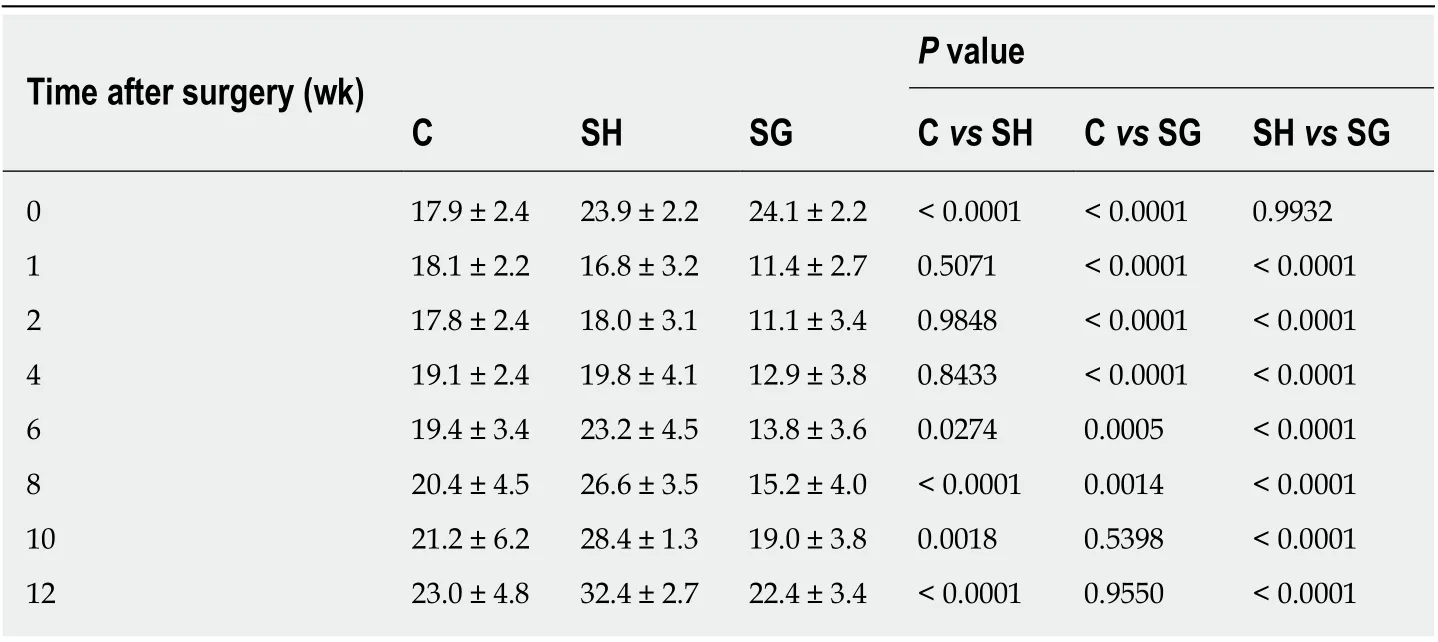
Table 3 Comparisons of food intake (g/d) among groups
In summary, obesity and T2DM significantly increase the risk of multiple diseases and cancer, in which, disruption in the ET-1 axis leads to ED and an increased risk of developing lung cancer. Nevertheless, with a profound effect of reducing body weight and improving glycometabolism and insulin sensitivity, SG improves endothelial function and exerts a protective role in preventing lung cancer by normalizing the ET-1 axis and weakening the effects of DNA damage. In the context of the current scarcity of basic research covering both cancer and bariatric surgeries,an attempt was made in the current study to provide new perspectives and lines of evidence for the role of SG in preventing cancer. We believe that these findings will deepen our understanding of anticancer effects of bariatric surgeries and broaden the theoretical basis for the evaluation of the surgical effect of SG, especially in supporting the clinical findings of bariatric surgery for lowering the risk of lung cancer. However,more future studies are warranted to uncover the other potential mechanisms of such effects.

Table 4 Comparisons of fasting blood glucose (mmol/L) among groups

Table 5 Comparisons of areas under curve of oral glucose tolerance test among groups

Table 6 Comparisons of fasting serum insulin levels (mlU/L) among groups

Table 7 Comparisons of insulin resistance (mlU × mmol/L2) among groups

Table 8 Comparisons of endothelin-1 mRNA expression among groups

Table 9 Comparisons of endothelin receptor A mRNA expression among groups

Table 10 Comparisons of endothelin receptor B mRNA expression among groups

Table 11 Comparisons of endothelin-converting enzyme-1 mRNA expression among groups

Table 12 Comparisons of relative endothelin-1 protein expression among groups

Table 13 Comparisons of relative endothelin receptor A protein expression among groups

Table 14 Comparisons of relative endothelin receptor B protein expression among groups

Table 15 Comparisons of relative endothelin-converting enzyme-1 protein expression among groups

Table 16 Comparisons of semi-quantified DNA damage levels (percentage of γ-H2AX-positive cells) among groups
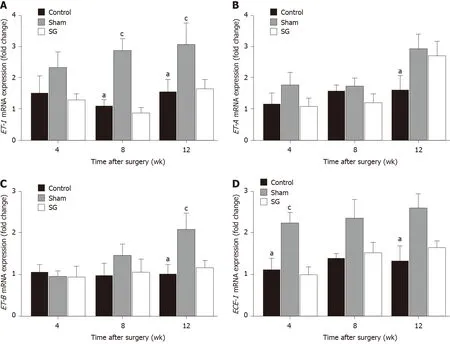
Figure 3 Expression of genes of the endothelin-1 axis.aP < 0.05: Control vs sham; cP < 0.05: Sham vs sleeve gastrectomy. SG: Sleeve gastrectomy.
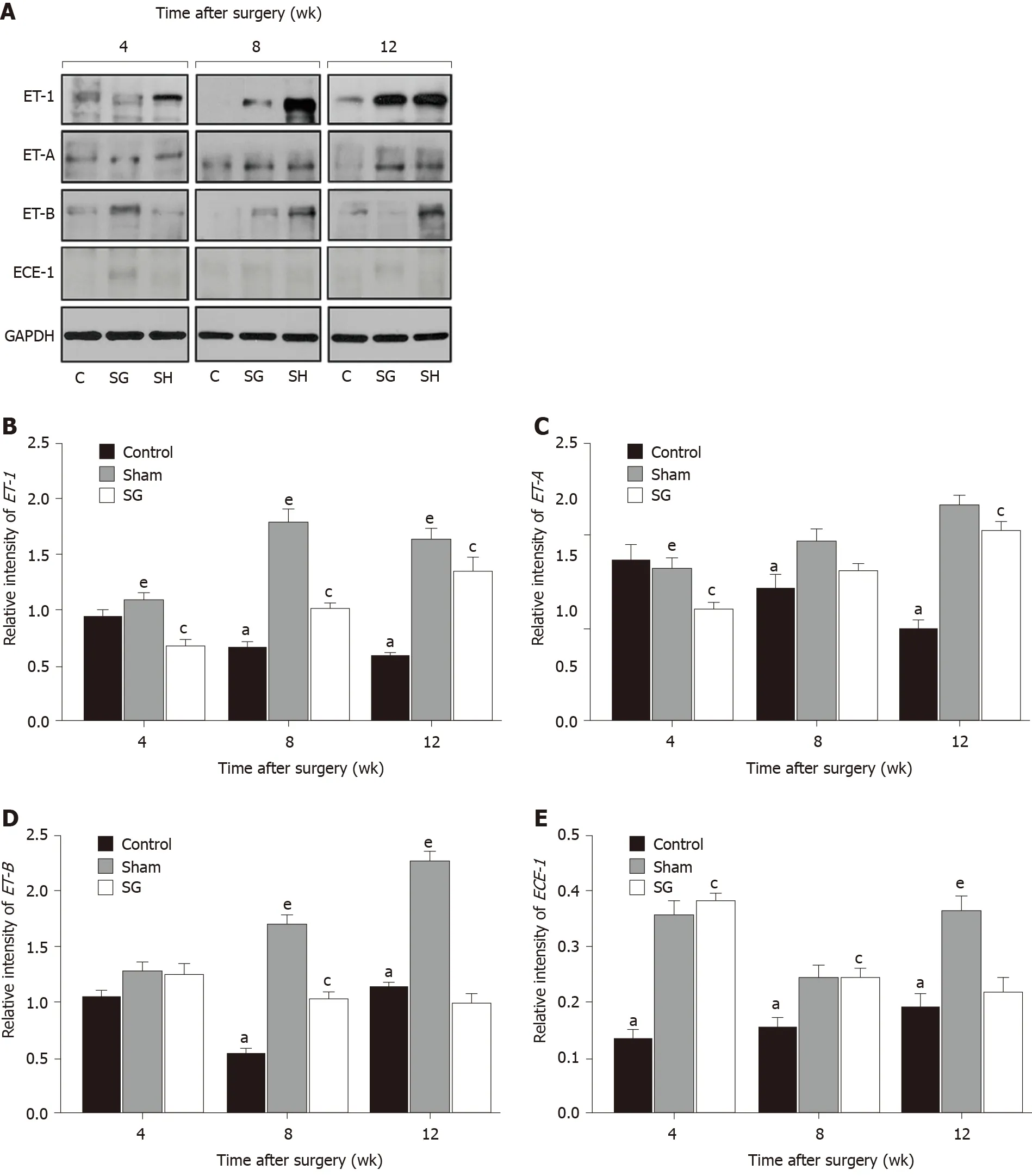
Figure 4 Protein expression of the endothelin-1 axis. A: Immunoblotting of the proteins; B-E: Relative band intensity. aP < 0.05: Control vs sham; cP < 0.05:Control vs sleeve gastrectomy; eP < 0.05: Sham vs SG. ET: Endothelin; ECE: ET-converting enzyme; SG: Sleeve gastrectomy.
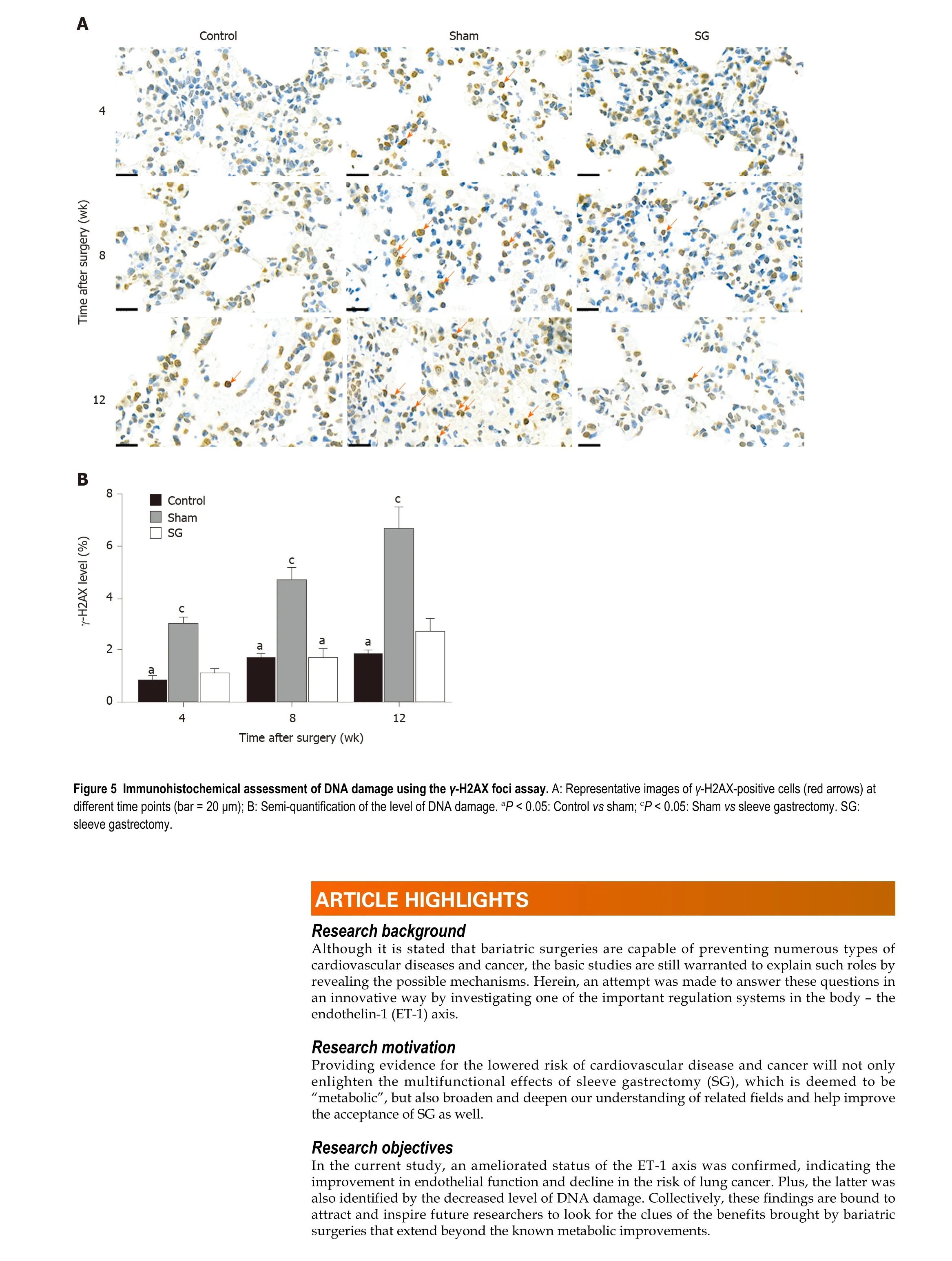
Research methods
SG and sham surgery were performed to clarify the effect induced on the ET-1 axis. In order to determine the real baseline of the parameters, healthy controls were also included. Moreover, the γ-H2AX foci assay was applied to provide stronger evidence of SG in preventing lung cancer,which was not an approach used commonly in previous research related to bariatric surgeries.
Research results
The results indicated that SG improved endothelial function and prevented lung cancer by normalizing the ET-1 axis, providing animal-based findings and suggesting new perspectives for the clinical field. The potential mechanisms of how SG effects the ET-1 axis and whether it is a direct impact or achieved by moderating metabolic disorder, however, need to be explored further.
Research conclusions
Beyond reducing body weight and improving both glycometabolism and insulin sensitivity, SG improves endothelial function and exerts a protective role in preventing lung cancer by normalizing the ET-1 axis and lessening DNA damage. These findings may present a new theoretical basis for clinical implications of SG.
Research perspectives
We believe that looking for more lines of evidence which expand our knowledge beyond the metabolic impact of bariatric surgeries is important, particularly because it will illuminate and illustrate the whole picture of the therapeutic effects of these procedures. Undoubtedly, factors that change under metabolic disorder and contribute to canceration, are the entry points and keys to the answer.
ACKNOWLEDGEMENTS
The authors thank Dr. Alimu Dayimu for reviewing the statistical methods.
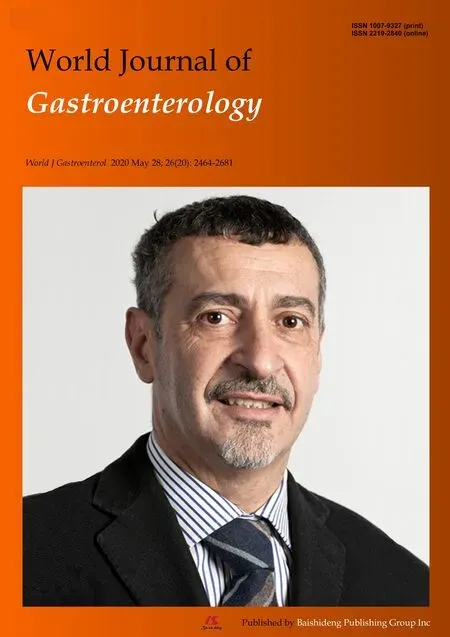 World Journal of Gastroenterology2020年20期
World Journal of Gastroenterology2020年20期
- World Journal of Gastroenterology的其它文章
- Percutaneous endoscopic gastrostomy – Too often? Too late? Who are the right patients for gastrostomy?
- Decreased of BAFF-R expression and B cells maturation in patients with hepatitis B virus-related hepatocellular carcinoma
- Anhedonia and functional dyspepsia in obese patients: Relationship with binge eating behaviour
- Clinicopathological features of early gastric cancers arising in Helicobacter pylori uninfected patients
- Role of gut microbiota-immunity axis in patients undergoing surgery for colorectal cancer: Focus on short and long-term outcomes
- Diet in neurogenic bowel management: A viewpoint on spinal cord injury
